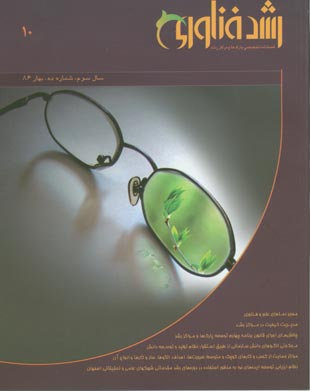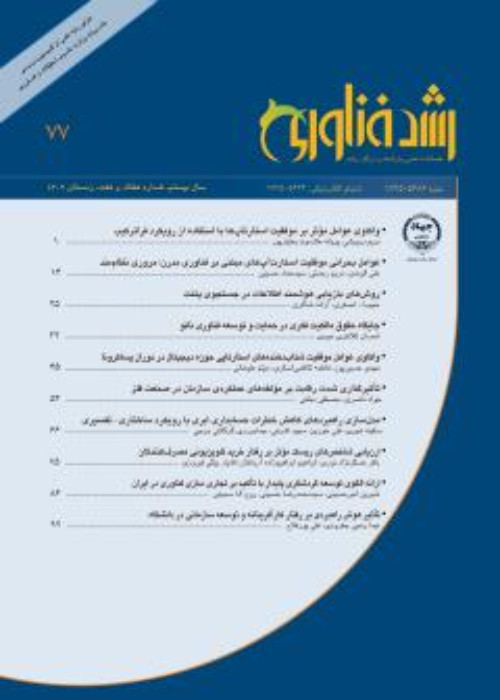فهرست مطالب

فصلنامه رشد فناوری
پیاپی 10 (بهار 1386)
- 68 صفحه،
- تاریخ انتشار: 1386/01/15
- تعداد عناوین: 11
-
صفحه 3
- میزگرد
- مقالات
-
صفحه 17شناخت شناسی فعالیت های دانشی سازمان ها گامی در راستای نیل به مهندسی ارزش منابع و دارایی های دانشی سازمان است. برای دستیابی به این هدف، بر اساس رویکرد محک زنی، نوزده شرکت شاخص بین المللی در حوزه های تبیین سازمانی، مدیریت دانش، محیط دانش پایه ای سازمان ها و رویکردهای تولید و توسعه دانش طی سال 1384 مورد بررسی قرار گرفت. الگوهای موفق شرکت های مذکور بر اساس ساز و کار حوزه های مورد تحلیل از دیگر هدف های مقاله است.
توجه به منابع و شناخت دارایی های دانشی سازمان ها، توانمندی بهره گیری از فرصت های آتی و گذر موفق از تنگناها و ارتقای مهارت رویارویی با تهدیدها و تبدیل آنها را به فرصت ارتقا می بخشد.
کلیدواژگان: دانش سازمانی، محیط دانشی سازمان، تولید و توسعه دانش -
نظام ارزیابی توسعه ایده های نو، به منظور استفاده در دوره های رشد مقدماتی شهرک علمی و تحقیقاتی اصفهانصفحه 25در دنیایی به سر می بریم که پیچیدگی رابطه علی و معلولی به شدت افزایش یافته است و کماکان این روند ادامه دارد. صاحبان ایده، حامیان آنها و ذینفعان به منظور آغاز یک فعالیت تجاری جدید با سؤال های متعددی روبرو هستند. سؤال هایی نظیر «آیا این ایده به موفقیت می رسد یا نه؟» و «چه نوع توجه و حمایتی برای موفقیت این ایده لا زم است؟» ارزیابی ایده برای نوآوران به منظور آشنایی با نقاط ضعف و قوت ممکن و نیز برای مدیران مراکز رشد به منظور پذیرش صاحبان ایده برای استقرار در آن مراکز و شروع حمایت های متناسب با نیازهای آنها در ابتدای فرایند نوآوری موضوعی بسیار لا زم و در عین حال جذاب است. «نظام ارزیابی اولیه امکان سنجی توسعه ایده های نو» به منظور ارزیابی امکان سنجی تجاری سازی ایده ها در ابتدای فرایند نوآوری تدوین شده است.
این مقاله ضمن معرفی این نظام به توسعه و بهبود آن به عنوان ابزاری برای کمک به مدیران مراکز رشد در فرایند جذب و پذیرش و پی بردن به حمایت های لا زم در طی مدت استقرار آنها و نیز آشنا شدن صاحبان ایده با موانعی که ممکن است به شکست آنها منجر شود، پرداخته است. بهبود نظام با در نظر گرفتن شرایط موجودتیم کاری متقاضیان استقرار در مرکز رشد صورت گرفته است. از جمله بخش های این مقاله، ارائه یک مطالعه موردی و تجزیه و تحلیل نتایجبه دست آمده از نظام مذکور است.
کلیدواژگان: مرکز رشد، فرایند، نوآوری، ارزیابی -
صفحه 33در این مقاله تلا ش شده است تا موضوع حمایت از کسب و کارهای کوچک و متوسط از زوایای مختلف بررسی شود و نسبت به ابهام زدایی هر چه بیشتر از آن اقدام گردد. انگیزه اصلی از نگارش این مقاله، مشاهده ابهامات و به تبع آن برخی ناهماهنگی های اجرایی در سیاست های توسعه کسب و کارهای کوچک و متوسط است که مهمترین نشانه آن فقدان یک راهبرد مدون برای توسعه واحدهای کوچک و متوسط و عدم وجود اولویت بندی بین فعالیت ها و برنامه های حمایتی مختلف است. برای رفع این ابهام تلا ش شده است از زوایای مختلفی همچون ضرورت ها، اهداف، الگوهای موجود، ساز و کارهای مورد استفاده و انواع حمایت از واحدهای کوچک و متوسط به مسئله پرداخته شود. بخش انتهایی مقاله جمع بندی و ارائه راهکارهایی است که نگارنده امیدوار است مورد دقت و توجه سیاست گذاران توسعه واحدهای کوچک و متوسط در کشور قرار گیرد.
کلیدواژگان: کسب وکار، حمایت ها، سیاستگذاری -
صفحه 40مسیرنماهای علم و فناوری1 که گاهی با عنوان «کارراهه» یا «نقشهراه» علم و فناوری نیز ترجمه شدهاست، در صنعت، دولت و دانشگاه برایبهتصویر کشیدن ارتباطی ساختاری بین علوم، فناوری ها و کاربردها استفاده میشود. مسیرنماها بهعنوان تصمیمیار2 بهمنظور بهبود هماهنگی بین فعالیتها و منابع در محیطهای دارای پیچیدگی و عدمقطعیت روزافزون، مورد استفاده قرار میگیرند.
کاربردهای مشخص مسیرنماها عبارتند از:1. مدیریت علم و فناوری، که شامل راهبرد، برنامهریزی، اجرا، بازنگری و گذار است;2. بازاریابی علم و فناوری;3. بهبود ارتباطات بین پژوهشگران، فناوران، مدیران تولید، تامینکنندگان، کاربران و سایر ذینفعان;4. شناسایی شکافها و فرصتها در برنامه های علم و فناوری;5. شناسایی موانع پیش روی توسعه و تولید سریع و کمهزینه.
همچنین مدیران علم و فناوری از مسیرنماها برای شناسایی حوزه های علم و فناوری نویدبخش نیز استفاده میکنند و از آنها برای شتاببخشی به روند تبدیل علم و فناوری به محصولات نهایی بهره میبرند. هنوز در ادبیات منتشرشده، به روش و تجربهتدوین مسیرنما ویا «مسیرنماسازی» توجه زیادی صورت نگرفته است. این گزارش، اولین تلاش برای گردآوری تعاریف متداول در روش و تجربیات مسیرنماسازی و تبیین وحدت درونی رویکردهای موجود علیرغم تفاوتهای ظاهری آنها است. این مقاله با تعاریف عمومی مسیرنماها شروع می شود و در بر دارنده گونهشناسی مسیرنماهایی است که هدف آنها، بهبود تحلیل و یکپارچگی طیفی گسترده از کاربردها و اهداف است. در ادامه، ویژگی مسیرنماهای گذشتهنگر و آیندهنگر نظیر ویژگی های فنون ترسیم نقشه علم و فناوری بر اساس ارزیابی مراجع3 شناسایی و تحلیل میشوند. جزئیات فرآیند ایجاد مسیرنماها، شامل اصول بنیادی برای ایجاد مسیرنماهای کیفی نیز ارائه میگردد.
-
صفحه 52در این مقاله ضمن مرور اجمالی بر اصطلاحات استانداردهای کیفیت از جمله مدیریت، نظامنامه، برنامه و اهداف کیفیت، نحوه پیادهسازی، مستندسازی و ارزیابی سیستم مدیریت کیفیت ایزو 9000 و نیز تدوین طرح تجاری مرکز رشد بر اساس آن ارائه میشود.
کلیدواژگان: مدیریت مرکز رشد، مستندسازی سیستم کیفیت، مدیریت کیفیت - گفتگو
- معرفی
-
صفحه 65
-
صفحه 67
-
Page 17How to reach to organizational knowledge activities diagnoses is the main step to utilize the value sources engineering organizational knowledge assets. I have this objective, by emphasis benchmarking approach around nineteen Intl significant firms. These firms analyzed on the field of organizational knowledge explanation. Knowledge management based organizational knowledge created and developed knowledge approaches during 1384. The other objective extended that successes patterns and its mechanisms where are and how we can use them. To increase key knowledge competencies, organization should to pay more attention to knowledge sources and assets until diagnosis future opportunities and take pass threats, transfer them to new opportunities.
-
Page 25We are living in a world where the complexity of cause and effect relations is in a continuous increase. The owners of the new ideas, their supporters and the beneficiaries encounter different questions for starting a new business activity. The questions such as Will this idea become successful or not? or What kinds of supports and considerations are necessary for this idea to be successful? are some examples. The idea assessment process is an important and interesting subject for both innovators and incubators managers so that it make the former familiar with the probable strengths and weaknesses and for the latter i.e. the managers of incubators the significance is in admitting the owners of ideas in incubators and starting to support them based on their needs in the early stages of the innovation process. The Innovation Development Early Assessment System has been developed for the assessment of the possibility of commercializing the ideas in the early stages of innovation. This paper will introduce this system and it further addresses the method of improving and developing it as a tool in the hands of the incubators managers helping them in the admission process of companies and helping them to recognize the support services required by their tenants during their residency in the incubator. It will also look at this system as a tool for making the owners of ideas familiar with the probable barriers and obstacles that may lead to their failure. The improvement method proposed for this system has been defined with regard to the existing conditions of the applicants of settlement in the incubator. A case study and the analysis of the results obtained through this system will come at the final part of this paper.
-
Page 33SMEs could be considered as Achile heel of economic development policies in most developing countries. While they have a majority in employment, unfortunately productivity is very low. Some policy makes prefer to neglect these and others have no coherent and contingent plan to help these firms. Some fundamental questions are presented and preliminary answers are discussed.
-
Page 40Science and technology (S&T) roadmaps are used in industry, government, and academia to portray the structural relationships among science, technology, and applications. Roadmaps are employed as decision aids to improve coordination of activities and resources in increasingly complex and uncertain environments. Specific uses of roadmaps include: S&T management including strategy, planning, executing, reviewing, and transitioning; S&T marketing; enhancing communications among researchers, technologists, product managers, suppliers, users, and other stakeholders; identifying gaps and opportunities in S&T programs; and identifying obstacles to rapid and low-cost product development. S&T managers also use roadmaps to help identify those S&T areas that have high potential promise, and to accelerate the transfer of the S&T to eventual products. However, there has been little attention paid to the practice of road mapping in the published literature. This paper is a first attempt to bring some common definition to road mapping practices and display the underlying unity of seemingly fragmented roadmap approaches. The paper begins with generic roadmap definitions, including a taxonomy of roadmaps that attempts to better classify and unify the broad spectrum of roadmap objectives and uses. Characteristics of retrospective and prospective roadmaps are then identified and analyzed, as well as summary characteristics of Bibliometric data based S&T mapping techniques. The roadmap construction process, including fundamental principles for constructing high quality roadmaps, is presented in detail.
-
Page 52In this paper some parts of quality standards such as quality management, manual, plan and objectives are reviewed and the implementation, documentation and auditing of quality management system at incubator and its business plan based on ISO 9000 standard are proposed.


